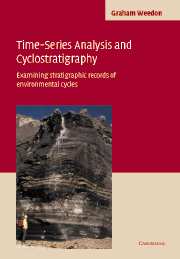Book contents
- Frontmatter
- Contents
- Preface
- Acknowledgements
- Chapter 1 Introduction
- Chapter 2 Constructing time series in cyclostratigraphy
- Chapter 3 Spectral estimation
- Chapter 4 Additional methods of time-series analysis
- Chapter 5 Practical considerations
- Chapter 6 Environmental cycles recorded stratigraphically
- Appendix – published algorithms for time-series analysis
- References
- Index
Chapter 2 - Constructing time series in cyclostratigraphy
Published online by Cambridge University Press: 13 August 2009
- Frontmatter
- Contents
- Preface
- Acknowledgements
- Chapter 1 Introduction
- Chapter 2 Constructing time series in cyclostratigraphy
- Chapter 3 Spectral estimation
- Chapter 4 Additional methods of time-series analysis
- Chapter 5 Practical considerations
- Chapter 6 Environmental cycles recorded stratigraphically
- Appendix – published algorithms for time-series analysis
- References
- Index
Summary
Introduction
This chapter is concerned with the acquisition of data and the generation of time series. The procedures discussed later in the book are based on the assumption that the time series used for analysis have been obtained with due regard for the issues addressed here. It is also assumed that care has been taken to ensure that the measurements or observations made are sufficiently reproducible (‘precise’) and accurate. Accuracy can be estimated via the analysis of material that has a known composition (i.e. a ‘standard’). ‘Analytical precision’ should be checked by multiple analyses of single samples. ‘Observational precision’ can be checked by re-sampling and re-analysing the section of interest (e.g. Fig. 2.1).
Currently four types of periodic or quasi-periodic environmental cycles that produce regular stratigraphic cyclicity have been studied in detail:
orbital variations generating the tides,
solar variability affecting the weather and climate,
orbital variations affecting the weather (daily and annual cycles) and climate (Milankovitch cycles), and
climatic variations arising from internal processes in the climate system.
Note that climate is typically defined as the mean and variability of the weather as observed during 30-year intervals (Barry and Chorley, 1998). Each of these types of environmental cycle and some of the time series characteristics are discussed in detail in Chapter 6. Missing from this list are cycles related to relatively poorly understood phenomena that might be responsible for some cyclicity observed in stratigraphic records. Principal among these is periodic fault activity (Cisne, 1986; Scholz, 1998; Morley et al., 2000).
- Type
- Chapter
- Information
- Time-Series Analysis and CyclostratigraphyExamining Stratigraphic Records of Environmental Cycles, pp. 21 - 42Publisher: Cambridge University PressPrint publication year: 2003



